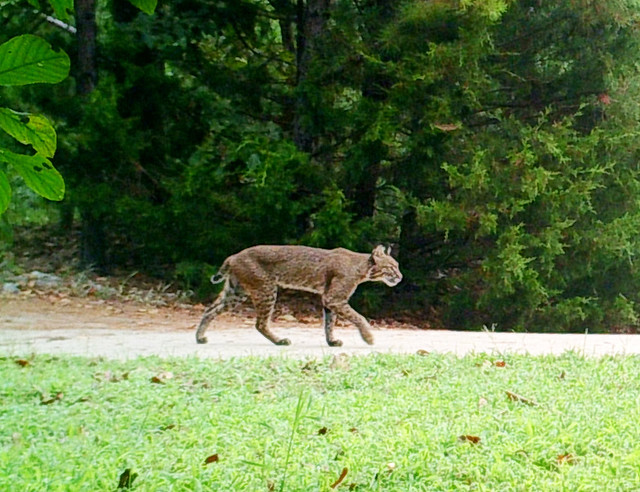Bobcats are adapting to urban and suburban settings. Here’s what to do if you see one
By Mary Hightower
U of A System Division of Agriculture
Nov. 6, 2019
Fast facts
- No reported attacks on people in Arkansas
- Bobcats can carry disease that affects domestic cats
(581 words)
(Download this story in MS Word format here).
LITTLE ROCK – As urban and suburban areas expand in Arkansas, the state’s wildlife — including the bobcat — is learning to adapt to new neighbors, said Becky McPeake, extension wildlife specialist for the University of Arkansas System Division of Agriculture.
“Bobcats are present in healthy numbers in the state,” she said. “According to the Arkansas Game and Fish Commission, despite popular perceptions of increasing numbers of bobcats, survey data indicate their populations have been relatively stable.”
Bobcats may seem more numerous because of their proximity to humans and people’s ability to differentiate them from domestic cats, McPeake said. Bobcats are not to be confused with mountain lions, which can be up to six feet long and weigh as much as 180 pounds. Mountain lions, also known as pumas, cougars or panthers, are larger, have no spots and have long tails. Bobcats, as their name implies, have short “bobbed” tails, spots, ear tufts and dark shading on their paws. Bobcats can weigh 11-35 pounds and are generally larger than domestic felines.
“Bobcats are typically shy but have learned to adapt to residential and urban environments,” McPeake said. “They roam any areas where they might find their prey and water.”
Prey for bobcats includes a variety of small animals, such as mice, rabbits, reptiles and occasionally a deer. Some suburb-dwelling bobcats also enjoy pets on their menus.
Various news accounts over the last few years in Arkansas have carried photos of bobcats in the suburbs, captured on security or game cameras.
Disease carriers
Bobcats can carry rabies, although it’s uncommon, McPeake said. In April 2019, various news accounts detailed a bobcat attack on a golfer and a horse. The bobcat was later captured and tested positive for rabies. There have been no reports of rabid bobcats in Arkansas, nor any Arkansas reports of bobcat attacks on humans.
However, bobcats can carry what’s called “bobcat fever,” a disease that can affect house cats, said Heidi Ward, extension veterinarian for the University of Arkansas System Division of Agriculture.
“Bobcat fever is caused by the tick-borne parasite, Cytauxzoon felis, which can be deadly in house cats,” Ward said. “Bobcats serve as a reservoir for the parasite, so they do not have any symptoms of disease. Cats, however, develop a fever followed by respiratory distress and death.”
Ward said in house cats, “the symptoms may develop anywhere from five to 20 days after the tick bite. Once the symptoms start, cats usually die after a few days if not treated.”
The lone star tick is the main carrier of the parasite.
“Unfortunately, the lone star tick has a very robust population in Arkansas due to our mild climate,” she said.
Bobcat encounters
McPeake has some safety tips for bobcat encounters:
- Make noise when walking or hiking in areas where bobcats occur.
- Keep dogs on a leash when walking; keep pets indoors.
- Never approach a bobcat, especially if near a kill or with its young.
- Never feed a bobcat.
- If the bobcat is cornered, back away and leave it an exit.
- Face the animal and slowly back away; don’t run away, as it is their instinct to chase.
- Stand tall and wave arms to appear larger.
- Speak firmly or shout.
- If the bobcat does not leave, consider throwing something at it.
To learn more about managing wildlife on your property, contact your county extension office, or visit www.uaex.uada.edu. Follow the Cooperative Extension Service on Twitter at @AR_Extension. Follow the Agricultural Experiment Station on Twitter at @ArkAgResearch and Instagram at ArkAgResearch.
About the Division of Agriculture
The University of Arkansas System Division of Agriculture’s mission is to strengthen agriculture, communities, and families by connecting trusted research to the adoption of best practices. Through the Agricultural Experiment Station and the Cooperative Extension Service, the Division of Agriculture conducts research and extension work within the nation’s historic land grant education system.
The Division of Agriculture is one of 20 entities within the University of Arkansas System. It has offices in all 75 counties in Arkansas and faculty on five system campuses.
Pursuant to 7 CFR § 15.3, the University of Arkansas System Division of Agriculture offers all its Extension and Research programs and services (including employment) without regard to race, color, sex, national origin, religion, age, disability, marital or veteran status, genetic information, sexual preference, pregnancy or any other legally protected status, and is an equal opportunity institution.
# # #
Media Contact: Mary Hightower
Dir. of Communication Services
U of A System Division of Agriculture
Cooperative Extension Service
(501) 671-2006
mhightower@uada.edu
